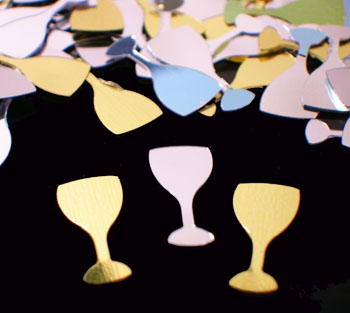While I was home celebrating Christmas with my family, I accrued several ideas for Daily Apple topics. But those are going to have to wait because none of them are suitable for New Year's Eve.
Confetti, however, is just the ticket.

Times Square, New York, 2013.
(Photo by Gary Hershorn/Reuters)

Confetti, or Jordan almonds, can be made in lots of different colors. According to one confetti maker, Pelino, different colors are appropriate for different occasions: white for weddings, red for graduations, green for engagements, light blue or pink for baby showers, and lilac for same-sex marriages.
(Photo from this Pinterest page on Jordan almonds)

The Casino de Paris was a bit of a wild place, apparently. Josephine Baker sang and danced there, they held wrestling and boxing matches, and they often featured scantily-clad or topless women dancers such as Mademoiselles Zazani and Whiard, pictured above. It was pretty much the place to go for a spectacle. It is still a very active venue, though I think it's more popular and less racy these days.
(I think these were originally postcards. Image from Candy Ping Pong)

Champagne flute confetti, available for $1.99 per 1/2 ounce packet from Chico Party Confetti.

Confetti cannon in action at a St. Patrick's Day parade in Kansas City.
(Photo by meliam, on Flickr)
I'm going to go look in on the madness at Times Square. I bet there will be confetti.

(Times Square, New Year's Eve, 2011.)
P.S. Check out the new section at the top right. Instead of telling you which Daily Apples are getting the most hits, which I think is something that only interests me, I've decided to give you links to Daily Apples that I think might be especially timely.
P.P.S. Happy New Year, everybody!
Sources
Online Etymology Dictionary, confetti
Confetti Pelino, The History of the Confetti Sulmona
Bella Umbria, Umbria Carnival in Italy
Big Site of Amazing Facts, Why Do We Throw Confetti?
Absolute Astronomy, Confetti
Wyrdology, What is Confetti?
Confetti Guru, Fun Facts About Confetti
American Heritage Blog, Ticker-Tape Parades, June 13, 2006
Confetti, however, is just the ticket.

Times Square, New York, 2013.
(Photo by Gary Hershorn/Reuters)
- Originally, confetti were little candies that Italians made for special occasions. The word comes from the Latin confectum, which is also the source for candy-like words such as "confection" and "comfit."
- The candies are also known as sugared almonds, Jordan almonds, or dragees.

Confetti, or Jordan almonds, can be made in lots of different colors. According to one confetti maker, Pelino, different colors are appropriate for different occasions: white for weddings, red for graduations, green for engagements, light blue or pink for baby showers, and lilac for same-sex marriages.
(Photo from this Pinterest page on Jordan almonds)
- These candies were made as far back as 1350 to celebrate lots of special occasions, including weddings, royal ceremonies, and banquets. Whether the confetti candies were thrown, besides just being served and eaten, I'm not sure.
- At some point, Italians did start to throw the candies during Carnival, which is similar to Mardi Gras. Both parties celebrate the days just before the 40 days of Lent starts and you're supposed to fast and abstain from eating meat and generally go into a kind of preparatory hibernation. Carnival is the last fling, so to speak, so it makes sense that you'd want to fling stuff. Har har.
- Italians call the paper stuff coriandoli.
- How confetti the candy turned into scraps of paper is uncertain. I found a few conflicting stories online:
- One source tells a very vague tale about how some guy thought he'd make a bigger profit if, instead of throwing real candy, he made candy-shaped cut-outs from cardboard and sold those instead. Some people did throw his fake cardboard candy, and over time the practice caught on.
- An 1895 issue of Scientific American magazine, widely referenced but nowhere quoted directly, supposedly reported that the first paper confetti was thrown in 1891 at the Casino de Paris in France. According to this article, an unnamed someone took down all the decorations left over after a New Year's Eve party. For some unknown reason, this person cut those decorations into smaller pieces. The following night, guests at the club threw the pieces of cut-up decorations from the balcony. People thought that was fun and the practice of throwing little pieces of paper and calling it confetti was born.

The Casino de Paris was a bit of a wild place, apparently. Josephine Baker sang and danced there, they held wrestling and boxing matches, and they often featured scantily-clad or topless women dancers such as Mademoiselles Zazani and Whiard, pictured above. It was pretty much the place to go for a spectacle. It is still a very active venue, though I think it's more popular and less racy these days.
(I think these were originally postcards. Image from Candy Ping Pong)
- It also became the practice, earlier than you might think, to throw confetti instead of rice at weddings. My trusty OED refers to people throwing confetti at a wedding in 1895.
- The first ticker-tape parade happened in 1886, to celebrate the dedication of the Statue of Liberty. Stock brokers in the offices that lined the streets where the parade took place spontaneously broke off the ticker-tape in their offices and threw it out the window. What interests me here is that people in the United States threw ticker tape, in confetti fashion, before people in France threw the first (documented) paper confetti.
- It's possible, I suppose, that this is sort of like the first time anybody did The Wave at a sporting event: lots of different events are claimed to be the first event, but the overall effect is that it seemed to be a thing people were doing all over the place for about a decade or so.
- Today, you can buy confetti in lots of different colors and shapes, for all sorts of occasions.

Champagne flute confetti, available for $1.99 per 1/2 ounce packet from Chico Party Confetti.
- At big public events where they blast lots of confetti into the air, the confetti is loaded into huge plastic barrels. At the appropriate time, the confetti is blasted forth using compressed air or carbon dioxide. They might also use an air mover (a big fan) to make the confetti fly farther or keep blowing around in the air.

Confetti cannon in action at a St. Patrick's Day parade in Kansas City.
(Photo by meliam, on Flickr)
I'm going to go look in on the madness at Times Square. I bet there will be confetti.

(Times Square, New Year's Eve, 2011.)
P.S. Check out the new section at the top right. Instead of telling you which Daily Apples are getting the most hits, which I think is something that only interests me, I've decided to give you links to Daily Apples that I think might be especially timely.
P.P.S. Happy New Year, everybody!
Sources
Online Etymology Dictionary, confetti
Confetti Pelino, The History of the Confetti Sulmona
Bella Umbria, Umbria Carnival in Italy
Big Site of Amazing Facts, Why Do We Throw Confetti?
Absolute Astronomy, Confetti
Wyrdology, What is Confetti?
Confetti Guru, Fun Facts About Confetti
American Heritage Blog, Ticker-Tape Parades, June 13, 2006
What a great post! Who knew there was so much to learn about tiny pieces of paper? www.satisfiedsole.com
ReplyDeleteHappy New Year, Apple Lady!
ReplyDeleteThis just in: Wikipedia has cited this entry as a source on confetti! I think it's time for a little confetti celebration.
ReplyDeletehttp://en.wikipedia.org/wiki/Confetti